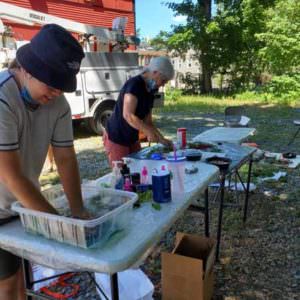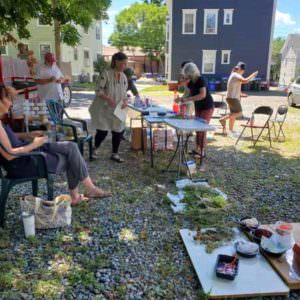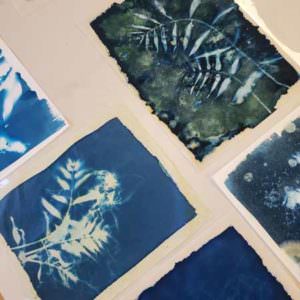 Artist Sarah Dunn writes on papers for cyanotype: “Generally when looking for papers to create cyanotypes, I traditionally want to find something with good absorbency and light in color. Papers with internal sizing, or sizing on one side will accept cyanotype chemistry with little to no bleeding. Choosing paper naturally light in color will allow for stronger contrast between the Prussian blue of the Cyanotype ground and the white silhouettes. You also want to ensure that whatever sheet you choose is strong enough to withstand agitation in a water bath.”
Artist Sarah Dunn writes on papers for cyanotype: “Generally when looking for papers to create cyanotypes, I traditionally want to find something with good absorbency and light in color. Papers with internal sizing, or sizing on one side will accept cyanotype chemistry with little to no bleeding. Choosing paper naturally light in color will allow for stronger contrast between the Prussian blue of the Cyanotype ground and the white silhouettes. You also want to ensure that whatever sheet you choose is strong enough to withstand agitation in a water bath.”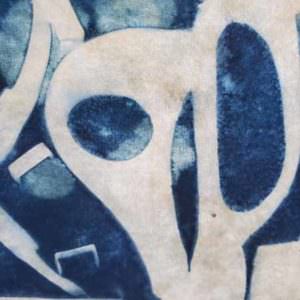
Some Japanese papers or “washi” tested out for Experimental (wet and dry) Cyanotypes on Washi workshop, July 2022 at Paper Connection in Providence, RI:
Kozo White Heavyweight G-0001 was made explicitly for inkjet printing, meaning this sheet has a coated surface for holding detailed printed ink on its surface, yet its absorbency should be even. Paper Connection carries a whole series of these “inkjet” papers in a series coded with “G.” Kozo White Heavyweight G-0001’s pure white tone provides a striking contrast to the blue of the cyanotype print. This washi is made mainly from the very strong Kozo (paper mulberry) fiber, it’s heavyweight and able to withstand agitation, moreover, you can leave it for quite a long time developing in a water bath.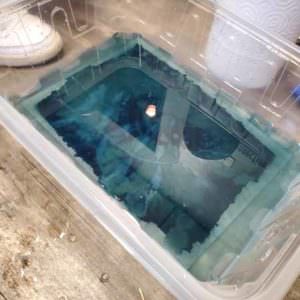
Other papers tested were: Kozo Natural Medium Weight M-0202, Mistumata Unryu Heavyweight G-0006, Green Tea Flecks on Green G-0016, Masa Soft White I-MM – Unlike the other 4 papers above, Masa Soft White I-MM is not made with any sizing at all.
Unusual and textured washi tested were: Kinwashi M-0268 – This paper was difficult to evenly chemically coat due to the irregular and uneven surface. The irregular coating could be considered a negative or positive, so experiment; enjoy the unexpected outcomes! You may also experience uneven “washout” when you have unevenly coated paper. Heavy White Crepe I-SDW was very textured but lost its “crepe-ness” with a wet coating; the texture also yielded an uneven coat. Again, this could be a pro or con depending on the effect you are going for.
A few DIY tips: if you are doing this process outside using the sun’s power, prepare medium-weight, folded, clear acetate or 2 pieces of Plexiglass to “sandwich” your work while it develops under the sun. You can also use stones and rocks for weights, however, they are a bit awkward to carry from spot to spot. You can leave your clear “sandwich” on the ground while it develops, avoiding movement. We still recommend having weights like stones in case the wind picks up! They are very handy!
Please join our mailing list and watch for future, paper arts workshops. We want you to be part of our COMMUNITY OF PAPER PEOPLE!

